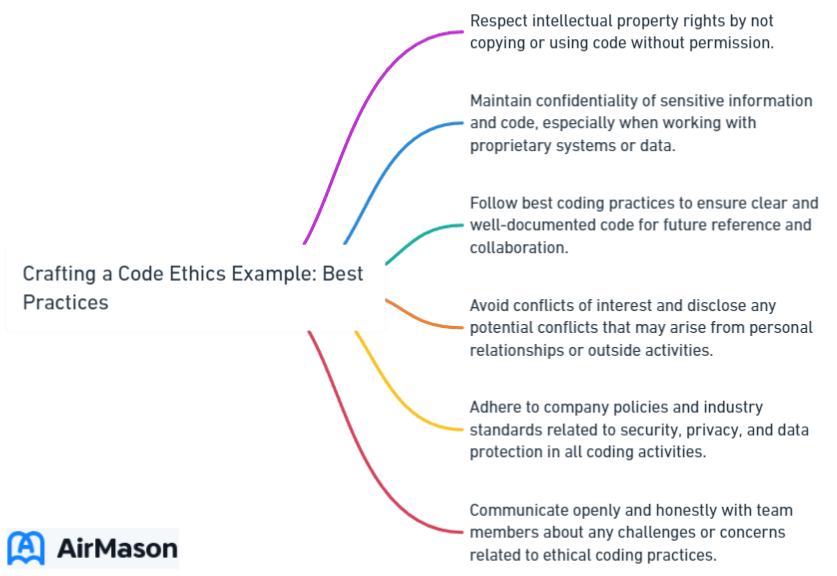
In today’s rapidly evolving world, ethical behavior has never been more critical for organizations and individuals alike. A well-crafted code of ethics serves as a moral compass, guiding decision-making, fostering trust, and cultivating a positive work culture. But how do you create an effective code of ethics that reflects your core values and addresses industry-specific concerns? Read on to discover best practices, real-life code ethics example, and valuable tips for crafting, implementing, and enforcing your own code of ethics.
Key Takeaways
- A code of ethics is essential to promote ethical behaviour and reflect an organization’s values.
- Crafting a comprehensive code should include core values, expectations, industry-specific considerations, stakeholder engagement and real life examples.
- Implementing and enforcing requires communication & awareness training, monitoring & reporting violations as well as ensuring accountability for actions taken.
Understanding the Importance of a Code of Ethics
A code of ethics is a key element in promoting ethical behavior and establishing a strong professional foundation. It serves as a guiding framework that helps individuals and organizations make ethical decisions and maintain their reputation. A well-formulated code of ethics can foster trust with customers, boost employee morale, and prevent legal issues.
A code of ethics not only delineates the ethical principles and guidelines that individuals and organizations should adhere to but also ensures that employees are treated fairly regardless of their mental and physical ability. From addressing matters such as harassment, safety, and conflicts of interest, to reflecting a company’s commitment to its values and expectations, a code of ethics plays a pivotal role in creating an ethical and responsible work environment.

Crafting an Effective Code of Ethics
An effective code of ethics arises from focusing on key aspects such as core values, clear expectations, industry-specific concerns, and stakeholder involvement.
Addressing these elements paves the way for a code of ethics that acts as a solid foundation for ethical behavior within your organization.
Core Values and Principles
Establishing a code of ethics starts with your organization’s mission statement and core values. Identifying the core values and principles which drive your business such as:
- honesty
- integrity
- fairness
- respect
- responsibility
Implementing these values into daily operations will ensure successful outcomes in the long run. These values should reflect your company’s mission and vision, providing a solid foundation for ethical behavior.
The inclusion of principles in your code of ethics helps to create a defined structure for ethical conduct and decision-making. This ensures uniformity in behavior and guides both individuals and organizations in making ethical decisions. By embedding principles such as:
- Integrity
- Professionalism
- Respect
- Equity
By ensuring that professionals conduct business honestly and integrating this principle into your code of ethics, you can foster an atmosphere of trust and ethical behavior.
Clear Expectations and Guidelines
Clear and concise guidelines for behavior are integral to crafting an effective code of ethics. These guidelines should address all aspects of your business conduct, including conducting business in areas such as:
- Conflicts of interest
- Anti-bribery
- Data privacy
- Environmental responsibility
By establishing explicit regulations for conduct, you can ensure that all employees understand their responsibilities and adhere to the company’s core values, demonstrating the company’s commitment.
Beyond covering key values and principles, providing employees with viable options for seeking guidance or reporting concerns is vital. By offering clear guidance on how to handle ethical dilemmas and report suspected violations, you can encourage a culture of openness, transparency, and accountability within your organization, fostering ethical decision making.
Addressing Industry-Specific Concerns
An effective code of ethics should also consider industry-specific ethical concerns and unique challenges. For example, healthcare, technology, and non-profit organizations all have distinct ethical considerations that should be addressed in their respective codes. By tailoring your code of ethics to address these unique concerns, you can ensure that your organization is well-equipped to navigate the ethical landscape of your specific industry.
In the healthcare industry, for instance, unique ethical concerns include:
- Striking a balance between care quality and efficiency
- Allotting restricted medications
- Enhancing access to care
- Upholding patient confidentiality and privacy
By addressing these industry-specific concerns in your code of ethics, you can create a comprehensive set of guidelines that effectively promote ethical behavior in your organization.
Involving Stakeholders
The development of your code of ethics must include stakeholder involvement, as it allows you to consider their perspectives and concerns, foster openness and accountability, and create a sense of ownership and commitment. Engaging stakeholders such as employees, clients, and partners can help ensure that your code of ethics reflects their needs and values, ultimately resulting in a more effective and relevant set of guidelines.
Collaborating with clients and partners when devising a code of ethics can bring numerous advantages, including:
- Establishing trust among stakeholders
- Providing a broader spectrum of perspectives
- Ensuring that the code reflects the values and requirements of all involved
- Fostering a positive work environment
By involving stakeholders in the creation of your code of ethics, you can ensure a more inclusive and comprehensive set of guidelines.
What Are the Codes of Conduct?
Codes of conduct are established sets of principles, rules, and guidelines that dictate appropriate behavior within a particular context or organization. These codes outline the expected ethical and professional standards that individuals associated with the organization should adhere to. “What are the codes of conduct” essentially refers to understanding the explicit and implicit guidelines that govern conduct in a specific environment. They provide a framework for decision-making and actions, emphasizing integrity, respect, fairness, and responsibility. Codes of conduct vary across different sectors, professions, and cultures, reflecting the unique values and priorities of the respective communities. Adhering to these codes helps maintain a harmonious and ethical environment, fostering trust and credibility among stakeholders.
Real-Life Code of Ethics Examples

Insights into the importance of crafting a well-structured code of ethics can be gleaned from examining real-life code of ethics examples from various industries such as healthcare, technology, and non-profit organizations.
These examples demonstrate how organizations have successfully developed and implemented their own company’s code, addressing industry-specific concerns, promoting ethical behavior, and promoting sustainable practices among their employees.
Example: Healthcare Code of Ethics

In the healthcare industry, a typical professional code, also known as a code of ethics, emphasizes patient care, confidentiality, and professional conduct. Healthcare professionals are expected to uphold standards of professionalism, demonstrate honesty in their interactions, report any deficiencies in character, and protect patients.
A healthcare code of ethics also addresses unique ethical concerns such as striking a balance between care quality and efficiency, ensuring informed consent for medical procedures, and maintaining patient confidentiality and privacy. By incorporating these industry-specific concerns into their code of ethics, healthcare organizations can create a comprehensive set of guidelines that effectively promote ethical behavior in the industry.
Example: Technology Company Code of Ethics

In the technology sector, a code of ethics typically focuses on data privacy, innovation, and responsible use of technology. Technology companies address data privacy in their code of ethics by implementing robust security measures and ethical guidelines that prioritize necessary steps to avoid privacy breaches and protect confidential and proprietary information. This includes investing in ethical data collection and sharing practices.
Accenture and the Association for Computing Machinery (ACM) are examples of technology companies that prioritize innovation in their codes of ethics. By addressing ethical concerns in technology development and deployment, such as data privacy, security, and responsible use, these organizations can foster a culture of ethical behavior and innovation within their industry.
Example: Non-Profit Organization Code of Ethics

For non-profit organizations, a code of ethics typically highlights transparency, accountability, and commitment to the organization’s mission. These principles ensure that non-profit organizations operate ethically and responsibly, prioritizing the needs of their stakeholders and the communities they serve.
A non-profit organization’s code of ethics should also address industry-specific considerations, such as safeguarding confidential information, abstaining from conflicts of interest, and refraining from any form of discrimination or harassment. By incorporating these unique concerns into their code of ethics, non-profit organizations can create a comprehensive set of guidelines that effectively promote ethical behavior and uphold their commitment to their mission.
Code of Conduct Examples
When establishing guidelines for appropriate behavior within an organization or community, it’s essential to provide clear and comprehensive code conduct examples. These examples serve as tangible references for individuals, outlining the expected standards of behavior and ethical principles. A code of conduct can cover a range of actions, from respectful communication and collaboration to guidelines on handling conflicts and adhering to legal and compliance requirements. By offering concrete instances of acceptable conduct, individuals are better equipped to navigate their roles, fostering a positive and inclusive environment. Additionally, code conduct examples can demonstrate a commitment to fairness, equity, and integrity, reinforcing a culture of respect and professionalism.
Tips for Implementing and Enforcing Your Code of Ethics

A multifaceted approach that includes effective communication, training, monitoring, and addressing violations is required to implement and enforce your code of ethics, while ensuring compliance with applicable laws and maintaining professional competence.
By focusing on these key aspects, you can ensure that your organization maintains a culture of transparency, ethical behavior, and accountability.
Communication and Awareness

For fostering a culture of ethical behavior within your organization, it’s vital to communicate your code of ethics to all stakeholders. Here are some ways to do that:
- Distribute copies of the code to employees
- Make the code available on your website
- Incorporate information about ethics into internal newsletters and communications
By implementing these strategies, you can ensure that everyone is aware of the code of ethics and its expectations, and reinforce the importance of ethical conduct.
Leadership plays a pivotal role in conveying a code of ethics in an organization. By setting the standard, acting as a model, and holding themselves and others accountable for ethical conduct, leaders can effectively communicate the importance of a code of ethics and create a culture of integrity and trust.
Training and Education

To ensure employees understand and adhere to the code of ethics, regular ethics training is indispensable. Some examples of ethics training that can be utilized to enhance employee engagement, decision-making, and understanding of the organization’s code of ethics include:
- Workshops
- Seminars
- Online courses
- Simulations
Training should be conducted on a regular basis, with some organizations opting for monthly discussions or ongoing training to ensure employees have the necessary information and moral code of conduct. By offering continuous training and support, you can foster a culture of ethical behavior and integrity within your organization.
Monitoring and Reporting

To maintain a culture of transparency and ethical conduct, it’s paramount to monitor ethical behavior within your organization and establish reporting mechanisms for suspected violations. By implementing robust reporting systems, such as internal reporting systems and anonymous hotlines, you can encourage employees to report any suspected violations and ensure that infringements are addressed promptly.
Technology can play a vital role in monitoring and reporting violations of a code of ethics, facilitating the collection and analysis of data related to ethical breaches and enabling reporting mechanisms. By leveraging technology, you can amplify the effectiveness and efficiency of monitoring and reporting processes, ultimately upholding your code of ethics and fostering a culture of ethical behavior.
Addressing Violations and Ensuring Accountability
To maintain a culture of transparency and ethical behavior, it’s necessary to promptly address violations and hold individuals accountable. By promoting and protecting whistleblowers, organizations can effectively address violations of their code of ethics and hold individuals responsible for their actions.
Ensuring accountability contributes to the implementation of a code of ethics by:
- Making individuals answerable for their actions and behaviors
- Providing a system for addressing infringements
- Forming a culture of transparency and trust
- Conveying a clear message that ethical behavior is a priority
By taking prompt action to address violations and ensuring accountability, organizations can maintain a culture of ethical conduct and integrity.
L Brands Ethics Hotline
The L Brands Ethics Hotline serves as a vital channel for employees and stakeholders to report concerns related to ethical conduct within the organization. Established by L Brands, the hotline is a confidential and secure platform that encourages individuals to report any unethical behaviors, potential violations of company policies, or other integrity-related matters. Employees are encouraged to use the L Brands Ethics Hotline to uphold a culture of transparency and accountability within the company. This resource demonstrates L Brands’ commitment to maintaining a high standard of ethics and integrity, fostering an environment where employees feel safe and empowered to voice their concerns. By leveraging the L Brands Ethics Hotline, the organization can swiftly address issues and take appropriate action, reinforcing its dedication to ethical business practices and compliance with relevant laws and regulations.
Summary
In conclusion, crafting an effective code of ethics is essential for guiding behavior, promoting trust, and establishing a positive work culture. By focusing on core values, clear expectations, industry-specific concerns, and stakeholder involvement, organizations can create a comprehensive set of guidelines that effectively promote ethical behavior. Implementing and enforcing a code of ethics through effective communication, training, monitoring, and addressing violations ensures a culture of transparency and ethical conduct. With these best practices and real-life examples in mind, you are well-equipped to craft, implement, and enforce your own code of ethics, fostering a culture of integrity and professionalism within your organization.
Frequently Asked Questions
What are the 5 codes of ethics?
The five codes of ethics are Integrity, Objectivity, Professional Competence and Due Care, Confidentiality, and Professional Behavior.
What is an example of the code of ethics for employees?
Employees should always conduct themselves professionally and with kindness, respecting the universal moral values of trustworthiness, respect, responsibility, fairness, kindness, and being a good citizen. Diversity and other green practices should also be celebrated.
What is an example of the code of ethics in healthcare?
Physicians must be dedicated to providing competent medical service with compassion and respect for human dignity. Additionally, they must treat patients and staff with respect and act honestly towards them, not using offensive language or engaging in fraud or deception.
What is McDonald’s code of ethics?
McDonald’s code of ethics emphasizes respect, safety, and dignity for all employees, promoting a workplace free from harassment and violence.
Why is a code of ethics important for organizations?
A code of ethics is essential for organizations as it creates trust and sets positive workplace norms, while also protecting the company’s reputation and guaranteeing fair treatment of employees.